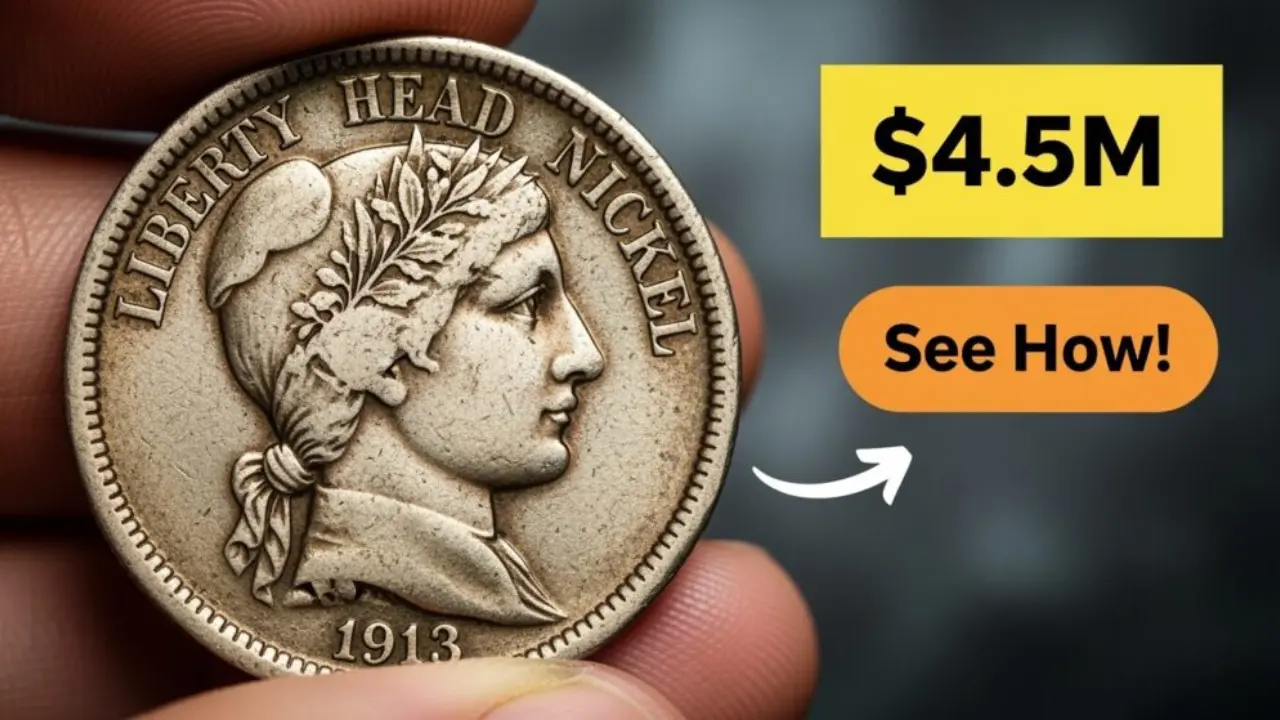The 1913 Liberty Head Nickel is one of the most enigmatic and fascinating coins in American history. It’s not just a five-cent coin; it’s a relic of mystery, intrigue, and immense value. This rare coin, which was never officially issued by the U.S. Mint, has been the subject of controversy, theft, and astronomical bids in auctions. Today, it is valued at approximately $4.5 million and is regarded as one of the rarest and most sought-after coins in the numismatic world. But what makes this coin so special? What is the story behind it, and why does it carry such a high price tag? Let’s delve into the history, features, and significance of the 1913 Liberty Head Nickel.
The History Behind the 1913 Liberty Head Nickel
The Liberty Head Nickel was first minted by the U.S. Mint in 1883 and continued to be in circulation until 1912. However, the 1913 version of the coin was never officially approved or released to the public. This discrepancy has fueled a great deal of intrigue and speculation in the numismatic community.
Table of Contents
According to historians, in 1913, an unknown employee at the U.S. Mint secretly struck five coins using the Liberty Head design. These coins were never authorized, nor were they meant to be part of the official currency issue. No official documentation exists to confirm their creation, making them a complete mystery. The coins were likely minted for a special purpose or for a private collection, but their origins remain uncertain.
The story of these five coins—now known as the 1913 Liberty Head Nickels—has contributed to their value and rarity. Over the years, these coins have sparked public interest, generating widespread debates among historians, collectors, and even law enforcement. Their mystery, combined with their extreme rarity, has only enhanced their allure.
Design and Features of the 1913 Liberty Head Nickel
The 1913 Liberty Head Nickel retained the classic design elements of the previous versions of the coin, making it both beautiful and dignified. The coin’s design symbolizes the strength and values of America, contributing to its historical significance and aesthetic appeal.
- Obverse: The obverse of the coin features Lady Liberty, portrayed with her hair tied in a bun, wearing a crown bearing the word “LIBERTY.” The design captures both elegance and solemnity, embodying the American ideals of freedom and progress.
- Reverse: The reverse of the coin features the Roman numeral “V” (for 5 cents), surrounded by stars and an olive branch. The olive branch is traditionally a symbol of peace and prosperity.
- Metal Composition: The coin was made from 75% copper and 25% nickel, which was a typical composition for U.S. coins at the time.
- Weight and Diameter: The coin weighs approximately 5 grams and has a diameter of 21.2 mm, making it comparable in size to other nickels of the era.
The 1913 Liberty Head Nickel’s design, simplicity, and symbolism have made it an enduring favorite among coin collectors. Its blend of historical significance and aesthetic appeal makes it one of the most prized coins in the world.
The Five Known 1913 Liberty Head Nickels
Only five original 1913 Liberty Head Nickels exist today. Each of these coins has a unique story, contributing to its mystique and value. Here are the known specimens:
- Eliasberg Specimen: Considered the finest example of the coin, this specimen was part of the collection of Louis Eliasberg, a renowned collector who completed a full U.S. coin collection. It was sold for $4.56 million in 2018, making it one of the most valuable coins ever sold.
- Olsen Specimen: This coin was owned by actor Fred Olsen and was featured on the popular TV show Hawaii Five-O. It is regarded as one of the best-preserved and most beautiful specimens of the 1913 Liberty Head Nickel.
- Walton Specimen: The Walton specimen went missing for nearly 40 years, making its rediscovery in 2003 a significant event in the numismatic world. It was authenticated and verified as a genuine 1913 Liberty Head Nickel after being hidden for decades.
- Norweb Specimen: Known for its sharp strike and minimal wear, the Norweb specimen remains in a private collection and is admired for its impeccable condition.
- McDermott Specimen: This coin is considered the most well-worn of the five, showing signs of heavy use. It is currently on display at the American Numismatic Association Money Museum in Colorado, allowing the public to view this historic coin.
Each of these coins has a storied past, and their value has only grown as they have changed hands in auctions and private sales over the years.
Why is the 1913 Liberty Head Nickel So Valuable?
The 1913 Liberty Head Nickel’s immense value can be attributed to several key factors:
- Extreme Rarity: The rarity of the coin is the most significant factor contributing to its high value. With only five known specimens in existence, the coin is one of the rarest in the world.
- Historical Mystery: The enigmatic origins of the coin have made it a subject of intrigue and fascination. Its creation was never officially acknowledged, and its origins remain shrouded in mystery.
- Condition: Coins in excellent condition fetch higher prices at auctions. The better-preserved coins, such as the Eliasberg and Olsen specimens, command particularly high prices due to their mint state status.
- Collector Demand: The demand for rare and unique coins among numismatists (coin collectors) has driven up the value of the 1913 Liberty Head Nickel. Wealthy collectors often bid heavily to acquire these coveted items.
- Auction Records: The 1913 Liberty Head Nickel has repeatedly broken auction records. Previous sales have surpassed the $4 million mark, with the latest sale reaching $4.56 million in 2021.
Auction History and Record-Breaking Sales
The 1913 Liberty Head Nickel has become a centerpiece of numismatic auctions. Each time one of the five coins is sold, it attracts massive attention from collectors and historians alike. Here are some of the key sales in the coin’s history:
- 2005 Eliasberg Sale: This coin sold for $3.7 million and set a new standard for rare coin values.
- 2010 Olsen Auction: The Olsen specimen fetched $4.15 million, continuing the trend of skyrocketing prices.
- 2021 McDermott Sale: The McDermott specimen set a new record, selling for $4.56 million, the highest price ever paid for a 1913 Liberty Head Nickel at the time.
These auction records highlight the growing demand for this rare coin and solidify its status as one of the most valuable coins in the world.
How to Identify a Genuine 1913 Liberty Head Nickel
Given the high value of the 1913 Liberty Head Nickel, it’s not surprising that counterfeit versions have surfaced. Identifying a genuine specimen requires careful attention to detail. Here are some methods used to authenticate the coin:
- Professional Grading: Reputable grading institutions, such as PCGS and NGC, evaluate coins for authenticity and assign them a grade based on their condition.
- Die Analysis: There are small, imperceptible differences in the die (impression) of authentic coins. Experts can analyze these details to confirm whether a coin is genuine.
- Provenance: The coin’s history and previous ownership records can help establish its authenticity. Coins with a documented chain of ownership are generally considered more reliable.
- Expert Examination: Scholars and numismatists pay close attention to the metal composition, depth of the strike, and wear marks to verify a coin’s authenticity.
1913 Liberty Head Nickel: A Symbol of American Heritage
The 1913 Liberty Head Nickel is more than just a valuable coin; it represents a piece of American history. The coin’s design reflects the values of liberty, peace, and prosperity, which are central to the nation’s identity. Despite its small size and simple design, the 1913 Liberty Head Nickel tells a larger story of American culture, politics, and the mysterious processes of minting.
Stored in museums or private collections, the coin remains a symbol of both the nation’s past and the complex nature of collecting. It is a golden page in American numismatic history, embodying the nation’s fascination with rare artifacts and the allure of the unknown.
Conclusion: A Coin That Transcended Time
The 1913 Liberty Head Nickel remains one of the most mysterious and sought-after coins in the world. With only five known specimens and a rich history filled with mystery, theft, and high-stakes auctions, it is no wonder that this coin commands such an extraordinary price. Each of the five known nickels has its own story to tell, adding to the coin’s allure and historical significance.
In the world of numismatics, the 1913 Liberty Head Nickel is more than just a piece of currency—it is a piece of American heritage, a symbol of the country’s culture, and a testament to the enduring fascination with rare and enigmatic artifacts. The value of this coin, both in monetary terms and historical significance, ensures that it will continue to be one of the most talked-about coins in American history.
FAQs
How many 1913 Liberty Head Nickels exist?
Only five genuine specimens are known to exist worldwide.
Why is the 1913 Liberty Head Nickel so valuable?
Its extreme rarity, mysterious origin, and historical significance make it one of the most valuable coins in the world.
How much is a 1913 Liberty Head Nickel worth today?
It is valued at approximately $4.5 million, depending on its condition and provenance.
How can I identify a genuine 1913 Liberty Head Nickel?
Genuine coins can be authenticated through professional grading, die analysis, provenance, and expert examination.
What makes the 1913 Liberty Head Nickel so unique?
Its creation was never officially documented, and only five coins exist, making it one of the rarest and most mysterious coins in the world.






